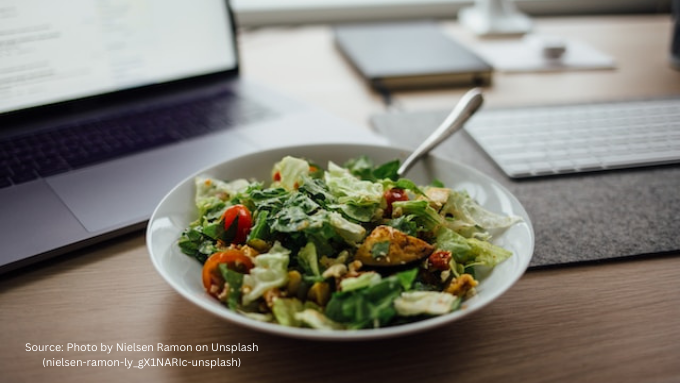Development of a Balanced Nutrition Menu and Nutritional Status of Teenage Santries in South Jakarta
Pengembangan Menu Gizi Seimbang dan Status Gizi Santri Remaja di Jakarta Selatan

Downloads
Background: Nutritional intake problems are common among santries due to a lack of varied balanced nutritional menus, which impacts nutritional status. As a result, menu modifications are required to improve santries nutritional status.
Objectives: Creating a balanced nutritional menu and understanding the relationship between daily intake and nutritional status of the santries.
Methods: Using mixed methods quantitatively and experimentally. The research subjects used a quota sampling of 25 santries as well as untrained panelists and 15 semi-trained panelists, namely nutrition students who were experienced in organoleptic testing. Intake data from 2x24 hour food recall and nutritional status data from anthropometric measurements. The development of a balanced nutritional menu is adjusted to the results of monitoring and filling out questionnaires regarding preferences for food ingredients. Data analysis uses the Spearman test to determine the relationship between variables.
Results: There is a relationship between energy intake (p-value = 0.050), protein intake (p-value = 0.005), and fat intake (p-value = 0.018) and student nutritional status; however, there is no relationship between carbohydrate intake (p-value = 0.188). The santries's fiber intake is still below the Nutritional Adequacy Rate, and the rainbow tofu hotpot is the result of developing a balanced nutritional menu that the santries enjoy the most.
Conclusions: The nutritional status of santries's related to their energy, protein, and fat intake. There is no link between carbohydrate intake and student nutritional status. "Rainbow Tofu Hotpot” is a nutritionally balanced menu that santries prefer in terms of color, taste, aroma, and texture.
Dwi Jayanti, Y. & Elsa Novananda, N. The Relationship Between Knowledge of Balanced Nutrition and Nutritional Status in Female Adolescents of Grade XI Accounting 2 (at SMK PGRI 2 Kediri City). J. Midwifery 6, 100-108 (2019).
Taqhi, S. A. The Description of Food Procurement System At the Hubulo Islamic. Indonesia Public Health Media 2, 241-247 (2014).
Rahman, N. Factors Associated with Eating Behavior in High School Adolescents of State Senior High School 1 Palu J. Prev. 7, 1-64 (2016).
Rahayu, P. S., Suparman, S., Dewi, M., Agung, F. & Hastuti, W. Asupan Energy Intake, Protein Intake, Physical Activity, and Nutritional Status in Female Adolescents at the Boarding School. J. Health. Siliwangi 2, 995-1003 (2022).
Kemenkes RI. Indonesia Health Profile. Indonesia Health Ministry. Pusdatin.Kemenkes.Go.Id (2014).
World Health Organization. World Health Statistics. Who vol. 1 (2011).
Kemenkes RI. Indonesia Health Profile 2018 Indonesia Health Ministry. Health Statistics (2019).
Kemenkes RI. Health Data Research (2018).
Kemenkes RI. Pocket Book for Monitoring Nutritional Status. Pocket Book 1-150 (2017).
Mahkota, T. C. & Soeyono, R. D. The Relationship Between the Level of Macro-Nutrient Consumption and Physical Activity with the Nutritional Status of Adolescents at Al - Achsaniyyah Boarding School, Kudus. (2021).
Atmalzier, S.Basic Principles of Nutritional Science. (2009).
Abdullah, Dewi, A. P., Muharramah, A. & Pratiwi, A. R. Overview of Nutritional Status and Nutrient Intake in Adolescent Students at Shuffah Hizbullah Islamic Boarding School and Al-Fatah Madrasah in Lampung. J. Aisyah Nutrition 5, 6-12 (2022).
Abbas tashakkori. Handbook Of Mixed Methods In Social and Behavioral Research. (2010).
Sugiyono. Quantitative, Qualitative, and R&D Research Methods. (PT Alfabet, 2016).
Kemenkes RI. Anthropometric Standards for Children. vol. 2507 (2020).
WNPG. Food Security and Nutrition in the Era of Regional Autonomy and Globalization. (LIPI, 2004).
Fitriyono, A. Food Technology: Theory and Practice. Knowledge Center 1-16 (2014).
Bachtiar, T., Satriani, S. & Hardiyanti, N. Analysis of Nutrient Content and Nutrient Intake of Students, as well as the Nutritional Status of Students at MA Sultan Hasanuddin, Pattunggalengang-Limbung, Gowa Regency, South Sulawesi. Sainsmat J. Natural Sciences 11, 21 (2022).
Faradilah, A., Syakir, D. & Akbar, A. Overview of Nutritional Status and Dietary Intake of Teenagers in Tahfidz Islamic Boarding School. Alami J. (Alauddin Islam. Medical) J. 2, 26 (2020).
Adi, A. C. Nutritional Status, Dietary Intake, and Sleep Duration of School Children: A Comparative Study : 7, 1-7 (2023).
Khoerunisa, Isti Istianah, D.The Relationship Between Macronutrient Intake, Physical Activity, and Nutritional Status in Adolescents. J. Food, Health, and Nutrition 2, 51-61 (2021).
Setiyaningrum, Z. Nutrient Intake and Nutritional Status of Female Adolescents at Firdaus Islamic Boarding School. J. Nutrition and Health. 3, 1-8 (2021).
Irdiana, W. & Nindya, T. S. The Relationship Between Breakfast Habits, Nutrient Intake, and Nutritional Status of Female Students at SMAN 3 Surabaya. Amerta Nutr. 1, 227 (2017).
Virlita, Destriatania, S. & Febry, F. Perception of Fiber Consumption Habits Among Junior High School and High School Adolescents in Palembang City in 2013. J. Public Health Science. 6, 74-82 (2015).
Sholichah, F. & Syukur, F.The Organization System of Meals in Tahfidz Islamic Boarding School. J. Research and Development in Indonesian Community Health. 1, 90-100 (2020).
Ningtyias, F. W. et al. Overview of the Food Organization System in Islamic Boarding Schools, Jember Regency. J. Medical Technology in Public Health 2, 25-34 (2018).
Humaira, S., Dewintha, R. & , Shelly Festilia Agusanti, M. Overview of the Food Organization System at Al-Fatah Islamic Boarding School, Singkawang. 5, 229-239 (2022).
Copyright (c) 2024 Amerta Nutrition

This work is licensed under a Creative Commons Attribution-ShareAlike 4.0 International License.
AMERTA NUTR by Unair is licensed under a Creative Commons Attribution-ShareAlike 4.0 International License.
1. The journal allows the author to hold the copyright of the article without restrictions.
2. The journal allows the author(s) to retain publishing rights without restrictions
3. The legal formal aspect of journal publication accessibility refers to Creative Commons Attribution Share-Alike (CC BY-SA).
4. The Creative Commons Attribution Share-Alike (CC BY-SA) license allows re-distribution and re-use of a licensed work on the conditions that the creator is appropriately credited and that any derivative work is made available under "the same, similar or a compatible license”. Other than the conditions mentioned above, the editorial board is not responsible for copyright violation.












































